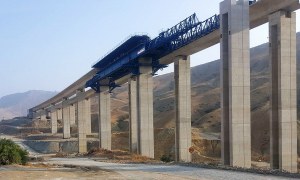🕑 Reading time: 1 minute
Contents:
Classification of steel bridges
Steel bridges are classified according to the Type of traffic carried, type of main structural system and the position of carriageway relative to the main structural system. These classification of steel bridges are briefly discussed in this section.Classification based on type of traffic carried
Bridges are classified as:- Highway or road bridges
- Railway or rail bridges
- Road - cum - rail bridges
Classification based on the main structural system
Many different types of structural systems are used in bridges depending upon the span, carriageway width and types of traffic. Classification, according to make up of main load carrying system, is as follows:(i) Girder bridges
Flexure or bending between vertical supports is the main Structural action in this type. Girder bridges may be either solid web girders or truss girders or box girders. Plate girder bridges are adopted for simply supported spans less than 50 m and box girders for continuous spans upto 250 m. Cross sections of a typical plate girder and box girder bridges are shown in Fig.1 (a) and Fig. 1(b) respectively. Truss bridges [See Fig.1(c)] are suitable for the span range of 30 m to 375 m. Cantilever bridges have been built with success with main spans of 300 m to 550 m. In the next chapter girder as bridges are discussed in detail. They may be further, sub-divided into simple spans, continuous spans and suspended-and-cantilevered spans, as illustrated in Fig.7. 3.
Fig.1 (a) Plate girder bridge section

Fig.1 (b) Box girder bridge section

Fig.1 (c) Some of the trusses used in steel bridges

Fig.2 Typical girder bridges
(ii) Rigid frame bridges
In this type, the longitudinal girders are made structurally continuous with the vertical or inclined supporting member by means of moment carrying joints [Fig.3]. Flexure with some axial force is the main forces in the members in this type. Rigid frame bridges are suitable in the span range of 25 m to 200 m.
Fig.3 Typical rigid frame bridge
(iii) Arch bridges

Fig.4 Typical arch bridges
The loads are transferred to the foundations by arches acting as the main structural element. Axial compression in arch rib is the main force, combined with some bending. Arch bridges are competitive in span range of 200 m to 500 m. Examples of arch bridges are shown in Fig. 4.(iv) Cable stayed bridges
Cables in the vertical or near vertical planes support the main longitudinal girders. These cables are hung from one or more tall towers, and are usually anchored at the bottom to the girders. Cable stayed bridges are economical when the span is about 150 m to 700 m. Layout of cable stayed bridges are shown in Fig. 5.
Fig.5 Layout of cable stayed bridges
(v) Suspension bridges
The bridge deck is suspended from cables stretched over the gap to be bridged, anchored to the ground at two ends and passing over tall towers erected at or near the two edges of the gap. Currently, the suspension bridge is best solution for long span bridges. Fig. 6 shows a typical suspension bridge.
Fig.6 Suspension bridge
Classification of Bridges based on the position of carriageway
The bridges may be of the "deck type", "through type" or "semi-through type". These are described below with respect to truss bridges.(i) Deck type bridge
The carriageway rests on the top of the main load carrying members. In the deck type plate girder bridge, the roadway or railway is placed on the top flanges. In the deck type truss girder bridge, the roadway or railway is placed at the top chord level as shown in Fig. 8(a).
Fig.7 Normal span ranges of bridge system

Fig.8 Typical deck, through and semi-through type truss bridges


